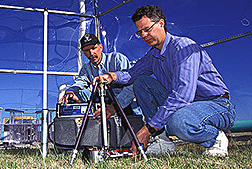This page has been archived and is being provided for reference purposes only. The page is no longer being updated, and therefore, links on the page may be invalid.
Elevated Carbon Dioxide Spurs Shrub Growth
By Rosalie Marion BlissAugust 28, 2007
Shrubs far outgrew native grasses in Colorado rangeland when exposed to elevated levels of carbon dioxide (CO2), according to a study published by Agricultural Research Service (ARS) scientists and cooperators at Colorado State University.
The results suggest that rising CO2 levels in the Earth’s atmosphere may be contributing to shifts in plant community dynamics, in which woody vegetation is favored over perennial forage grasses.
The study will be published in this week’s online edition of the Proceedings of the National Academy of Sciences. Plant physiologist Jack A. Morgan, research leader of the ARS Rangeland Resources Research Unit in Fort Collins, Colo., led the study. ARS is the U.S. Department of Agriculture's chief scientific research agency.
During the past 200 years, shrubs have expanded their reach into many of the world's grasslands, reducing the amount and quality of forage available to livestock. Some scientists theorize that elevated atmospheric CO2 concentrations have spurred that growth. But evidence as to the underlying reasons behind the problem of woody plant encroachment has been lacking.
The experiment was conducted on native short grass prairie in northern Colorado. To simulate elevated atmospheric CO2 conditions and make comparisons, the scientists used six large open-top chambers. Three of the chambers were infused with air injected with 360 parts per million (ppm) of CO2—to model today's atmosphere. The other three chambers were infused with air injected with twice the control amount—or 720 ppm—of CO2. That's roughly the atmospheric concentration expected by the end of the century.
Among the 34 plant species exposed to 720 ppm of CO2, the scientists found a 40-fold increase in aboveground biomass of fringed sage, Artemisia frigida, a widespread shrub in rangelands of North America and Asia. Growth of only one other species, Stipa comata, a relatively low-forage-quality perennial grass, was also significantly affected by the CO2, as previously reported. S. comata showed only a two-fold increase in biomass due to CO2.
The results support present theories that rising CO2 may be altering the botanical structure of world grasslands and contributing to their degradation.

